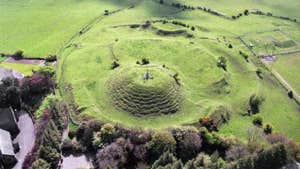Built around 1199 by Norman knight Richard de Tuite as part of an initiative to extend Norman control over the country, Granard Motte and Bailey was erected upon and within a pre-existing ring fort (or rath) which may have belonged to a local branch of the Farrell clan.
The motte is a great, flat-topped, circular earthen mound, on top of which would have historically been a timber tower surrounded by a palisade. Across the base was a u-shaped bailey, an enclosure surrounded by a palisade ditch. Animals and soldiers were housed in the bailey. It is very strongly fortified, except on the southern side, which seems to have been guarded solely by the deep trench on the summit, out of which defenders fired arms and hurled stone missiles at the approaching enemy.
Standing 534ft above sea level, it is reputed to be the highest motte in Ireland. The summit affords a view of five lakes, parts of nine counties, and a faint outline of the Sliabh Bloom Mountains. Many myths are attached to the motte – some say there is a castle concealed within it, others say it contains vast treasures of gold, while yet others maintain that the hollow in the centre was a grain store.
In 1932, a statue of St. Patrick was erected on top of the motte to mark the coming of the saint to Ireland in 432AD.
Visit the Knights & Conquests Heritage Centre nearby. Don the clothes of our Norman ancestors and walk on an interactive journey through time.
